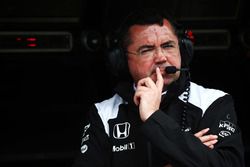FIA confident it can police radio clampdown
The FIA is adamant that it has what it takes to fully police Formula 1's radio clampdown, and will be able to catch out teams trying to get around the rules with coded messages.

Photo by: XPB Images














Ahead of the 2016 season, motor racing's governing body is enforcing tighter restrictions on what teams are able to tell drivers over team radio.
Although some have expressed scepticism about the ability of the FIA to ensure teams fully comply with the radio limits, F1 race director Charlie Whiting says it should be straightforward to make sure all teams comply.
"We are listening to it in real time," he explained in a media briefing ahead of the Australian Grand Prix.
"So we have got four people in race control listening to three drivers each. And then we have got four or five software engineers listening to two or three each.
"So it is relatively straightforward, and quite honestly they are not saying that much."
Coded messages
Whiting is well aware that teams will try all they can to give their drivers maximum information – and that there may be temptation to try to use coded messages.
However, he says the FIA will be listening out for such activity, and will be building up a database of knowledge to check teams are not doing anything suspicious.
"We will hear every single message, I am absolutely sure of that," he said. "With coded messages, we have to be a little bit careful about that.
"We could, for example, if we have some suspicion that a message is rather odd, we could then look at the data from the car to see if the driver did anything in response to that message.
"Then maybe, at the next race, if we hear the same message and notice the same switch change, then we will build up a little knowledge."
But Whiting said talk of teams using silly phrases as code could be discounted, because the FIA had laid down limits of what is allowed.
"I can't tell you how a coded message will work," he said. "It will depend entirely upon what the message is and what the explanation is for that message.
"But by putting down exactly what you can say, if you go outside of that it is fairly obvious. I have had some very strange questions about 'the birds are flying high in the sky today.' But I will just say it is not on the list.
"I would also say by using some of these things on the list, there is probably a way of getting a message across that we were not intending them to but we will have to deal with that on a case-by-case basis."
Filming pit boards
As well as listening to the radio messages, Whiting said that the FIA would be filming team pit boards to ensure that they were not used to pass along information outside the scope of the restrictions.
"They are allowed to give the same messages that they are allowed to pass on the radio, and no more," he explained.
"There has been some suggestion that by putting the lap count for example in red, it means something, if it is yellow it is means one thing, if it is white it means another. Those sorts of things.
"We have a camera looking at all the pit boards so if we see something unusual then we might have to ask why.
"I think they will do their very best to try to get as much information as they can to the drivers, but I just hope that they continue to do it in a legal way."
Further additions
Whiting also said that a fresh clarification had been issued on Friday to allow further limited communications to the drivers beyond what had been in place ahead of this weekend.
These are:
- Teams can tell a driver to stay out.
- Teams can talk to the driver on the grid.
- Teams can tell a driver when to turn off the 'delta' time procedure once they have crossed the Safety Car line twice.
- Teams can tell drivers to do certain test routines during P1 and P2.
If a team accidentally breaches the rules it would likely get a reprimand, but more serious offences could result in time penalties.
Be part of Motorsport community
Join the conversationShare Or Save This Story
Subscribe and access Motorsport.com with your ad-blocker.
From Formula 1 to MotoGP we report straight from the paddock because we love our sport, just like you. In order to keep delivering our expert journalism, our website uses advertising. Still, we want to give you the opportunity to enjoy an ad-free and tracker-free website and to continue using your adblocker.















Top Comments